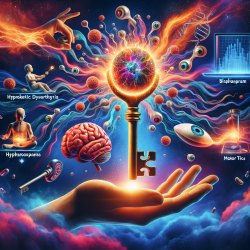Understanding the ANO3 Gene and Its Impact on Motor Disorders
In the ever-evolving field of speech-language pathology, staying abreast of the latest research can significantly enhance therapeutic outcomes. A recent study published in BMC Medical Genetics sheds light on a novel ANO3 variant found in a 53-year-old woman presenting with hyperkinetic dysarthria, blepharospasm, hyperkinesias, and complex motor tics. This discovery not only broadens our understanding of genetic influences on motor disorders but also offers new avenues for intervention.
The Case Study: A Unique Presentation
The case involved a 53-year-old female who developed a mixed hyperkinetic disorder post-hip arthroplasty. The symptoms included chorea, dystonia affecting the upper extremities, dysarthria, and blepharospasm. Whole exome sequencing revealed a novel heterozygous missense variant in the ANO3 gene, which encodes anoctamin-3, a protein involved in neuronal excitability. This variant had not been previously documented, highlighting the complexity and variability of dystonia presentations.
Implications for Practitioners
For practitioners, this case underscores the importance of considering genetic testing when presented with atypical neurological phenotypes. The use of whole exome sequencing in this case was pivotal in identifying the genetic underpinnings of the disorder, which can guide targeted interventions. Here are some key takeaways for practitioners:
- Consider Genetic Testing: For patients with complex or atypical motor disorders, genetic testing can provide crucial insights that inform treatment plans.
- Stay Informed: Keeping up with the latest research can reveal novel therapeutic targets and strategies.
- Collaborate with Geneticists: Working closely with geneticists can enhance diagnostic accuracy and treatment efficacy.
Encouraging Further Research
This case report also highlights the need for further research into the ANO3 gene and its role in motor disorders. As more cases are documented, patterns may emerge that could lead to the development of new therapeutic approaches. Practitioners are encouraged to contribute to this growing body of knowledge by documenting and sharing their own case studies.
Conclusion
The discovery of a novel ANO3 variant in this case provides valuable insights into the genetic basis of motor disorders. By integrating genetic testing into clinical practice and staying informed about the latest research, practitioners can enhance their ability to deliver effective, personalized care. To delve deeper into this research, you can access the original paper here: A novel ANO3 variant identified in a 53-year-old woman presenting with hyperkinetic dysarthria, blepharospasm, hyperkinesias, and complex motor tics.










